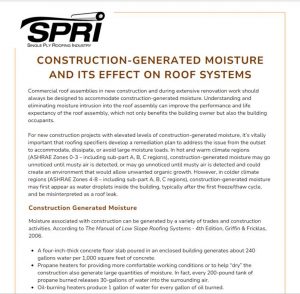SPRI, Inc. has posted a new document addressing construction-generated moisture and its impact on commercial roofing systems.Photo courtesy
SPRI, Inc., the trade association for the manufacturers of single-ply roofing systems and related component materials, has posted a new document addressing construction-generated moisture and its impact on commercial roofing systems.
The paper, titled “Construction-Generated Moisture and its Effect on Roof Systems,” was written by SPRI’s technical director, Chadwick Collins. Construction-generated moisture comes from many activities such as pouring concrete, burning propane heaters, painting, plastering, and drywall finishing. These activities and others can contribute to excessive levels of relative humidity (RH) inside the structure when proper remediation measures are not taken. The result can be condensation within the roofing assembly and within the structure when the temperature is at or below the dew point.
To control construction-generated moisture, roof design professionals must identify the sources of moisture and develop a remediation plan to implement during the design process.
Among the list of specific SPRI recommendations are avoiding the use of wet materials, or materials with excessive moisture, and penetrating vapor barriers, installing vapor retarders in the roof assembly, installing at least two layers of insulation, and always sealing deck-to-wall joints and gaps around roof penetrations.
The paper can be accessed through here.
www.constructionspecifier.com
https://www.constructionspecifier.com/spri-shares-research-on-how-construction-related-moisture-effects-roofing/















